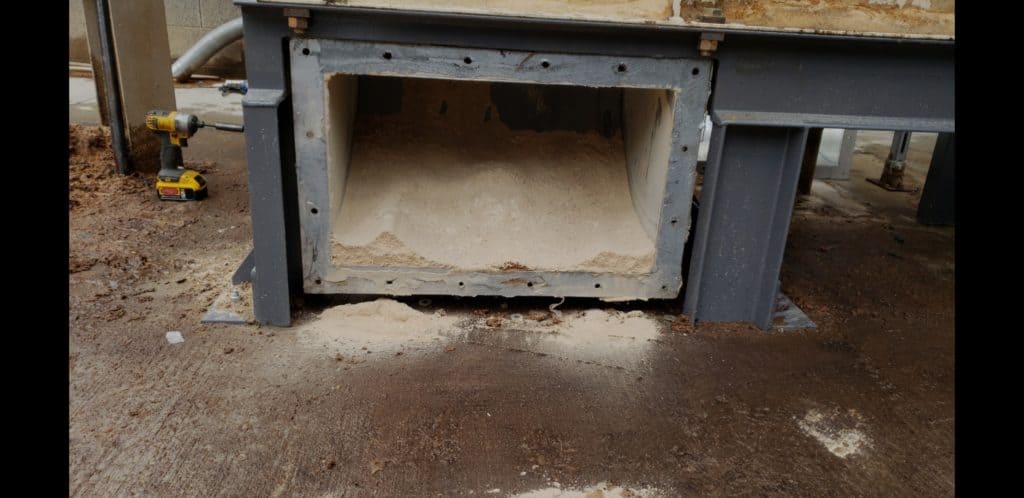
by Imperial Systems | May 2, 2018 | Uncategorized

1. What information do we need to start designing a system and what are the considerations for ductwork?
- First, you need to know about your dust. Important details: how it’s being generated, how toxic or hazardous it is, what exposure levels OSHA considers to be too high, whether it is combustible and/or explosive, particulate size, physical characteristics.
- Combustible dust will certainly require special precautions in the system design to protect the facility and workers from deflagration or explosion. Dust testing can determine how explosive dust is and the needed precautions.
- A general layout of the facility and each location generating dust.
- A sketch of the ductwork layout, including the location of the dust collector, fans, and ductwork branches.
- A plan for the type of hood to use at each of the dust capture locations. Also, how much CFM each one will require.
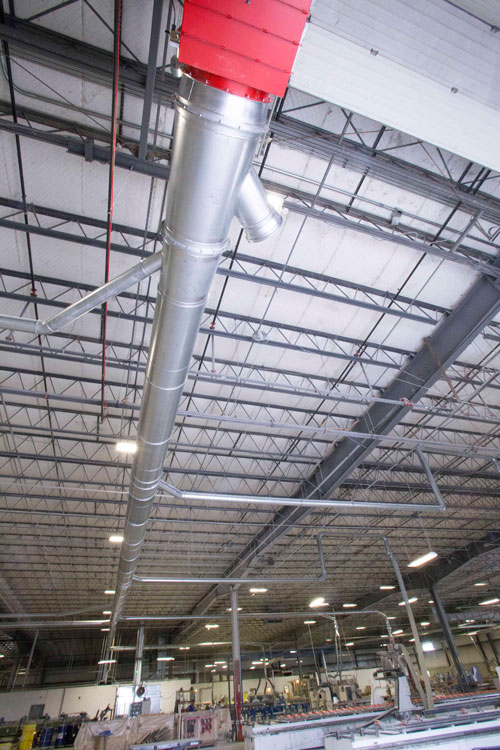
2. What are the basic components of a dust collection system?
- Hoods: must be the correct design for each type of machine. They must also be efficient at removing the produced dust by that machine.
- Ducts: must be the correct size to allow proper airflow and keep air moving. They also must not have too many bends or elbows to slow down the airflow. This can allow particulates to drop out of the airflow. It can also create a point for wear and tear on the ductwork.
- Fan: the fan must be powerful enough to keep air moving through all the ductwork at a high enough velocity. Drops in velocity or not enough velocity can allow dust to fall out of the air stream.
- Collector: must be the correct size for the system. It must have an air-to-cloth ratio that makes it able to filter all the air coming into the collector. Must have correct filter material to handle the size and type of particulate. This could be DeltaMAXX nanofiber for most applications, or spunbond, PTFE, or other specialized filters for particular applications. Further, filters must be fire-retardant if the dust is flammable.
- Fire Prevention: devices such as spark arrestors can help keep sparks from entering the dust collector. A water or chemical fire suppression system can extinguish sparks or flame when a sensor detects them.
- Venting/Exhaust: If returning air to the building, it must be clean enough to meet all health and safety standards. If dust is toxic, it may necessitate an extra layer of safety in the form of HEPA filters. A backdraft damper can prevent backdrafts from allowing dust back into the system. An abort gate with spark detector can sense a spark or flame, diverting the flame in a safe direction.
3. What is the process for designing a ductwork system?
- System design should start with identifying each place that a hood or other source capture point needs to go. In other words, anywhere that generates dust.
- Use appropriate calculations to figure out how much CFM you need at each of these points
- Determine the minimum duct velocity. This is based on the transport velocity (the airflow needed to keep your particular dust moving in the air stream).
- Calculate the size of duct for each branch. This is based on the CFM and the transport velocity and will be different for different spots along the ductwork.
- Increase duct velocity at each branch to maintain transport velocity until all branches are connected to the main duct.
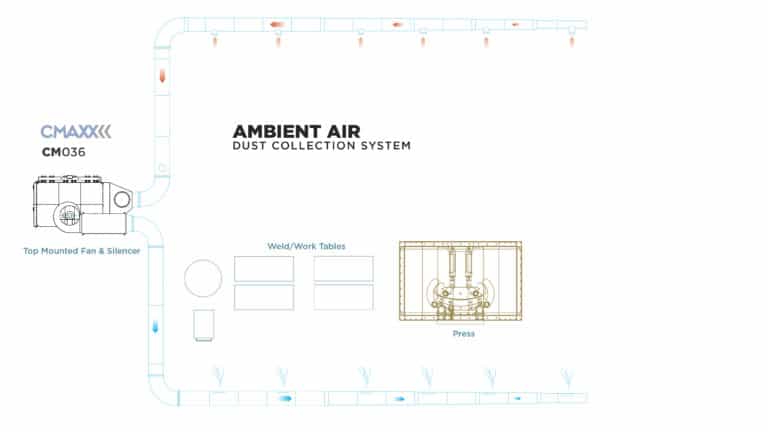
4. Will this be an ambient system or source capture system?
- Ambient system: removes air from the entire work area. It filters and recirculates it back into the area, diluting contaminated air with clean air.
- Air changes per hour: the number of times per hour that the total amount of air in the area changes. This is from old/contaminated air to new/clean. The calculation is made with the cubic volume of the work area and the number of required air changes to maintain air quality.
- Source capture/close capture: captures generated dust at each point throughout the facility.
- This type of system must have properly designed hoods at every capture point. Perform and double-check your airflow calculations. Specialty hoods can be designed for almost any application.
- Static pressure in these systems is an algebraic formula. It includes a loss at hoods, flex ducts, transitions, and straight ductwork runs. Minimal use of elbows and flex ducts in the ductwork runs will greatly improve system efficiency.
- For dangerous or toxic dust where exposure must be kept to an absolute minimum, a close capture system will keep the material from entering the air of the general workplace.
We hope this set of articles about ductwork help to answer some of your questions. Please thank the knowledgeable and experienced Charlie Miller for providing so much valuable information and sharing his wisdom.
Read more
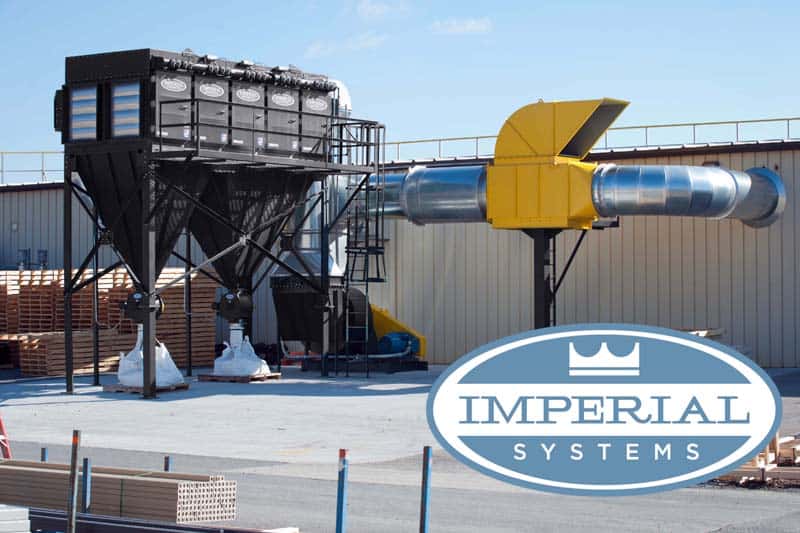
by Imperial Systems | Sep 29, 2016 | Uncategorized
The Surprising OSHA Game That’s Actually Fun
You might actually find yourself playing this just to try for a high score. I’m not kidding. For the sake of accurate reporting, I forced myself to test out this OSHA Hazard Identification Training Tool. I even forced myself to test it more than once after I managed to crash my profits on the first try. This was solely for testing purposes and had nothing to do with being annoyed about losing.
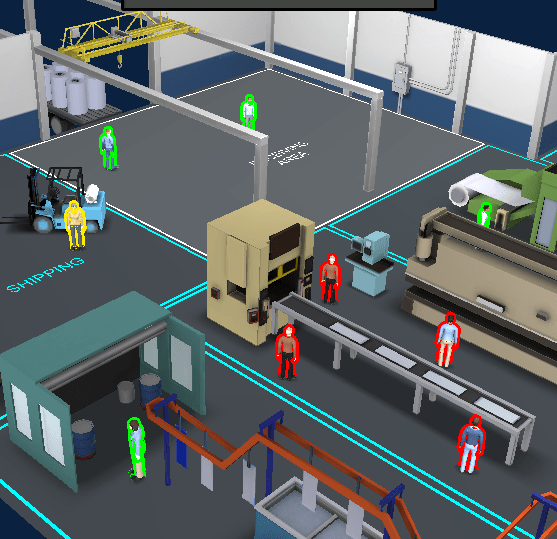
Apparently, someone at OSHA is a fan of farm or city management games, because their Hazard Identification Training Tool is really a time and resource game. This OSHA training tool focuses on three different workplaces: construction, manufacturing, and an emergency room. Most relevant for most of the companies we work with would be manufacturing, which allows you to play as either an owner or a worker in a facility that manufactures metal parts.
OSHA Training Tool Simulates Realistic Company Challenges
In the game… err, OSHA training tool … you are challenged to balance profit and safety. You have a certain number of points to spend each week on safety tasks like inspecting machines, interviewing workers, and doing research. Any points you do not use contribute to your profit. However, major safety failures also wreck your profits, so you have to make your safety investments wisely.
Wait a minute. A government agency actually recognizes that companies have to balance their safety efforts with trying to make a living?
Yes, it seems like they do. And this game provides a lot of information, with each safety step you choose getting a rating of the hazard and a choice of whether or not to spend safety points fixing it. Since there are far more possible hazards than you have safety points for each week, you have no choice but to prioritize which safety issues to deal with first and which can probably wait.
Wait another minute. They’re not telling you that you have to fix all the hazards right this minute?
No. This OSHA training tool requires you to budget both time and money. It sounds almost like real life. Fixing hazards will cost money. An incident because of a safety hazard you didn’t fix will also cost money.
Keep Safety in the Green
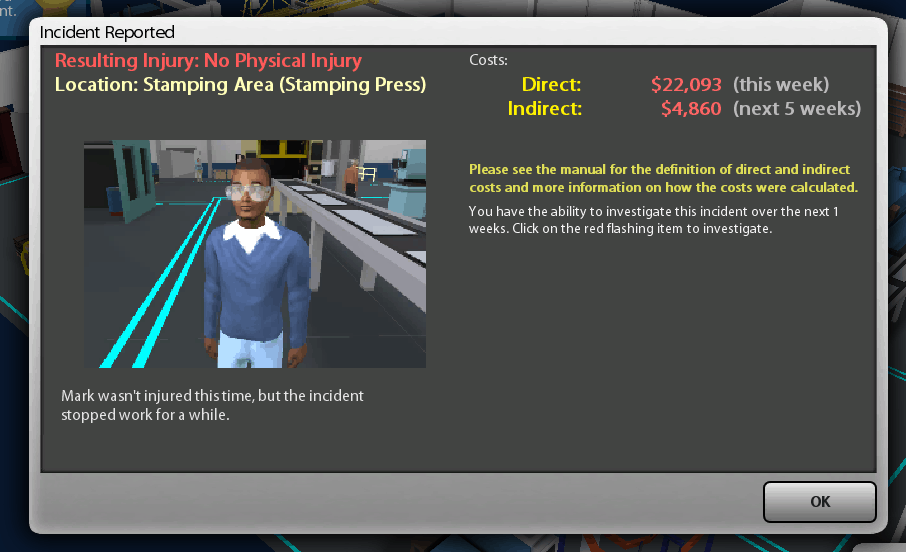
(Mark made it out OK this time, but it still took a chunk out of my profits.)
Some safety issues you’re presented with in the game are very simple to fix, like rearranging power cords so they’re not where people can trip over them. Others are more complicated, like installing machine guards, and some go all the way up to replacing broken machinery or installing engineering controls (such as a dust and fume collection system).
The best choices keep both your safety rating and your profit margin in the green. And some of them even make your job easier.
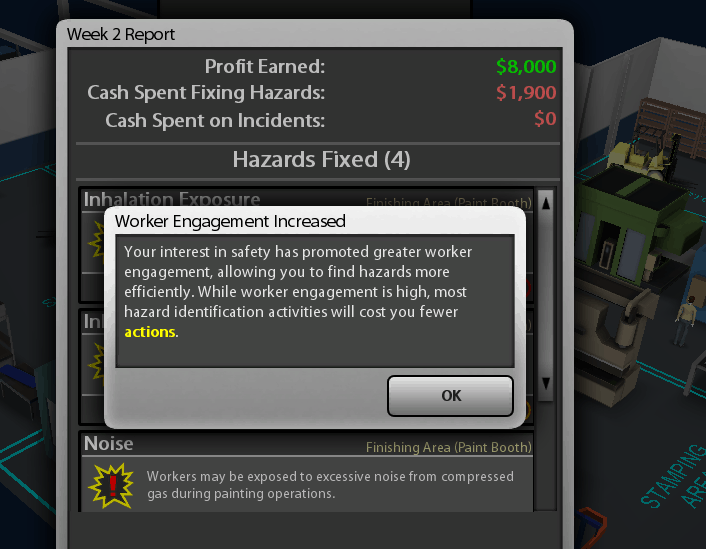
Talking to workers about the things they’re concerned about makes you better at finding hazards, so you can turn more points into profit. Workers will even report things to you so you can fix them, which is easier than finding them yourself.
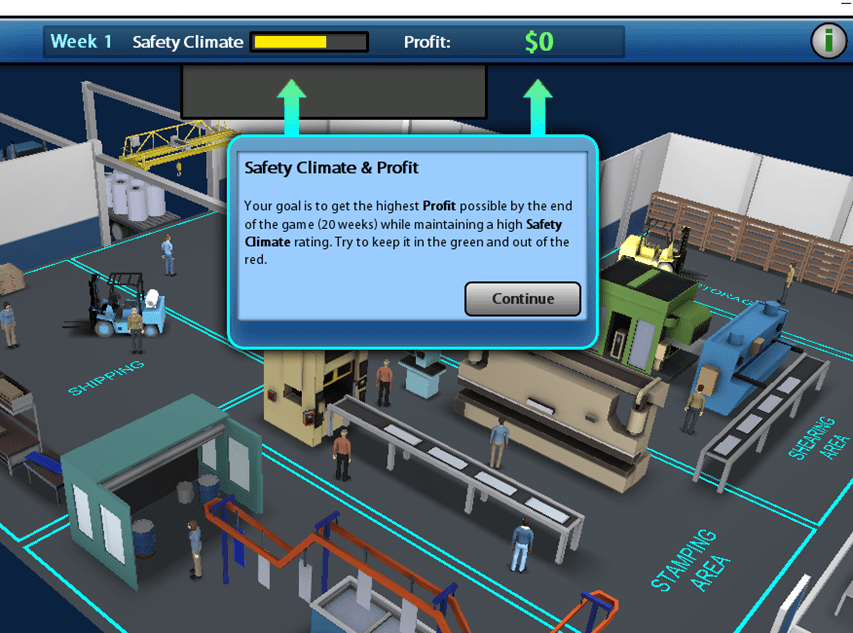
(Uh-oh… there’s apparently a hazard in the stamping area. The folks in the receiving area are pretty happy, though.)
Some of the hazards you find are minor, and some aren’t. Each of them costs money to fix but improves your safety rating. You can visually inspect a machine, watch people using it, or check the owner’s manual. You spend your money repairing exposed electrical wiring, putting up new shelving to store boxes properly, or fixing the air quality control in the paint booth. Or you can just tell them to quit playing football in the loading dock.
And best of all, how can anyone complain that OSHA training on hazard assessment is a waste of time? Clearly, this is valuable information.
Now, if they’d just improve the graphics a little… Find it here: https://www.osha.gov/hazfinder/
Read more
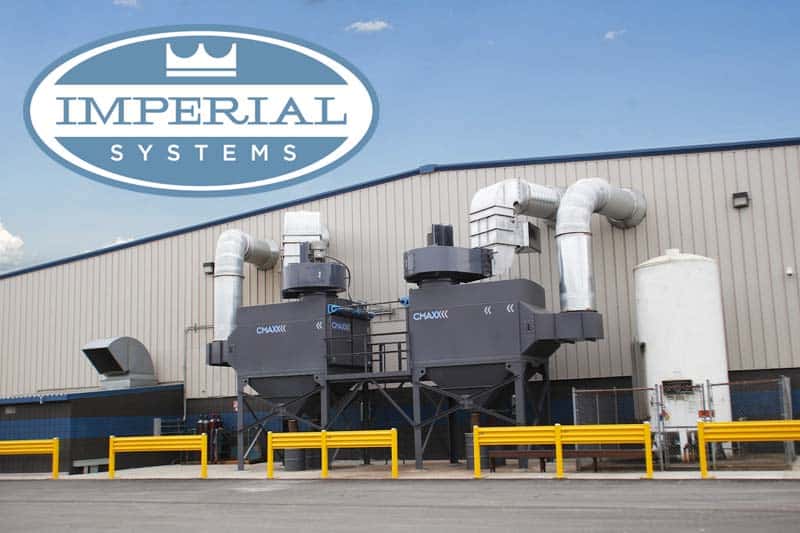
by Imperial Systems | Aug 31, 2016 | Uncategorized
Afraid to report unacceptable safety conditions at your work site? OSHA can protect you from retaliation.
It is a known fact that many workers are forced to work in unsafe environments. Most companies certainly strive to provide safe and healthy working conditions for their employees. However, there are some places that are unwilling to make worker safety a top priority. If you know you are in a situation where your safety and others who work with you are at risk, you may have fears of losing your job if you bring it to anyone’s attention.

The stigma of being a whistleblower is not what it used to be in the past. In fact, OSHA has a program in place that protects your rights as an employee. Such provisions include:
- The right to file a safety complaint to OSHA
- Protection from employer retaliation, such as termination
- The right to participate in OSHA inspections and talk to the inspector
- The right to review employer exposure and/or injury records
OSHA has fined many corporations due to the unfounded termination of employees who report safety violations. It is simply against the law, and in the end, costs the company more than just fixing the safety problem itself.
Keep in mind that sometimes it may not be malicious intent by your employer. Even more, they may not be aware of safety issues that concern you. So, how do you approach this situation? Read this informative article that gives you tips and advice about talking to superiors with confidence.
All in all, there are many options for shop and factory workers to be part of the solution in making their job safe. Click on the links below if you have questions or want to learn more about safety in the workplace.
http://www.whistleblowers.gov/index.html
https://www.osha.gov/workers/index.html
OSHA NEWS: http://bit.ly/2bX9j1E
Read more









